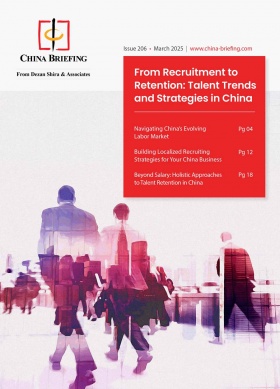Mapping Tariff Risk: Which Chinese Cities Are Most Exposed to Foreign Trade?
China’s trade exposure is unevenly distributed, with coastal and border Chinese cities most vulnerable to tariff risks, while inland provinces are emerging as resilient trade nodes. Proactive national and local policies have been released to diversify markets, strengthen logistics, and enhance long-term economic resilience.
As global trade frictions resurface, particularly with renewed threats of tariff escalation targeting Chinese exports, understanding the regional distribution of trade reliance across China becomes increasingly important. While China’s national export performance remains resilient, with Q1 2025 exports rising 6.9 percent year-on-year to RMB 6.13 trillion (841.22 billion), the degree of exposure to foreign trade varies significantly across provinces. Some regions, especially those built on high-volume manufacturing and cross-border trade, are far more vulnerable to external shocks than others.
Trade dependency, typically measured as the ratio of a region’s total imports and exports to its GDP, provides a useful proxy for assessing tariff sensitivity. A high dependency ratio often reflects dynamic integration into global markets, but it also signals heightened exposure to geopolitical volatility and trade barriers.
Cities such as Shenzhen, Dongguan, and Jinhua (home to Yiwu) routinely record foreign trade volumes that exceed their total economic output. Meanwhile, border cities like Chongzuo in Guangxi have become critical nodes in China’s land-based trade with Southeast Asia. These areas stand at the forefront of new trade frictions, bearing the brunt of policy uncertainty, shipping disruptions, and shifting global demand.
In this article we examine which provinces and key industrial cities are most reliant on foreign trade, explores how sectoral composition shapes tariff vulnerability, and reviews the latest local and national policy responses aimed at mitigating external pressure. As China continues to navigate an increasingly fragmented global trading system, regional disparities in trade exposure will shape both the risk profile and resilience of the country’s export-driven economy.
Trade dependency ratio as a risk indicator
In the context of escalating global trade tensions, the trade dependency ratio—defined as the total value of imports and exports relative to a region’s GDP—serves as a critical metric for assessing exposure to external economic shocks. While high trade dependency often signals strong global integration and export competitiveness, it also points to greater vulnerability to tariff-related disruptions, especially when value chains are heavily dependent on foreign demand or imported inputs.
Provincial-level trade reliance
Across China, provinces along the eastern and southern coastlines display the highest trade dependency ratios. Guangdong, for instance, recorded over RMB 2.09 trillion (US$286.81 billion) in exports in Q1 2025 alone, powered by its manufacturing giants in Shenzhen and Dongguan. Jiangsu and Zhejiang also maintain substantial exposure, with both provinces ranking among the top three in terms of absolute export volume and consistently exceeding national averages in trade-to-GDP ratios.
Notably, trade-driven inland provinces like Sichuan and Chongqing have seen rising dependency as they integrate into transnational value chains and Belt and Road logistics corridors. While their overall trade volumes remain lower than the coastal heartlands, the rapid pace of growth, particularly in electronics and automotive parts, signals emerging exposure that warrants closer monitoring.
City-level manufacturing and export hubs
Within these provinces, specific cities exhibit outsized roles in foreign trade relative to their economic scale. Shenzhen and Dongguan remain core export engines, with each city’s trade volume exceeding local GDP in some years. Yiwu, under the jurisdiction of Jinhua in Zhejiang province, is another key player, specializing in small commodities and maintaining strong links with markets across Asia, Europe, and the Middle East.
Further inland, Chongzuo in Guangxi has emerged as a vital land port for ASEAN trade, especially under the Regional Comprehensive Economic Partnership (RCEP). While often overlooked in national trade discussions, these city-level nodes are acutely exposed to changes in border policies, shipping rates, and tariff structures.
As a result, both provincial and sub-provincial data are indispensable when evaluating who stands to lose or adapt the most in the face of shifting global trade policies. With Q1 2025 showing a record RMB 10.3 trillion (US$1.41 trillion) in total trade volume and a 6.9 percent growth in exports despite softer global demand, the stakes remain high for regions that have long staked their economic strategies on cross-border commerce.
Top trade-reliant provinces and their industrial makeup
Guangxi: Chongzuo leads in border trade
Topping the national list for trade reliance is Chongzuo, Guangxi, where total trade volume now exceeds its GDP, highlighting a dependency above 100 percent. Strategically located on the Vietnam border, Chongzuo hosts one of China’s highest concentrations of land ports, including the pivotal Friendship Pass. It continues to anchor land-border trade and is central to the development of the China-Vietnam railway corridor.
Zhejiang: Jinhua (Yiwu) as the world’s marketplace
In Zhejiang, Jinhua—particularly its Yiwu district—is renowned for its role as the “world’s supermarket.” The city’s export dependence exceeds 100 percent, driven by robust e-commerce and light manufacturing sectors. It remains one of China’s most export-oriented economies, leveraging a strong private sector and global buyer network.
Guangdong: Shenzhen and Dongguan dominate high-value manufacturing
Guangdong remains a cornerstone of China’s external trade, with Shenzhen and Dongguan among the country’s highest-ranking cities by total trade value. Shenzhen alone exceeded RMB 4 trillion (US$548.92 billion) in trade volume in 2024. These cities specialize in electronics, telecommunications, and machinery, and have built a robust export ecosystem supported by advanced logistics and port infrastructure.
Jiangsu: Suzhou and Wuxi power export manufacturing
Suzhou is one of China’s few cities with an export dependence approaching 98 percent, reflecting a heavy reliance on international markets. Together with Wuxi, it forms the backbone of Jiangsu’s high-tech and auto parts manufacturing, contributing significantly to China’s electronics and machinery exports.
Fujian: Xiamen and Quanzhou extend coastal competitiveness
With over 100 percent trade dependence in Xiamen, Fujian continues to capitalize on its coastal advantages. Apparel, electronics, and chemicals form the core of its export mix. The province has recently proposed further integration of domestic and international trade, seeking to certify “dual-circulation leader” firms with global competitiveness.
Interior cities gaining ground: Chengdu and Chongqing
While coastal cities remain dominant, inland cities like Chengdu and Chongqing are gaining momentum, supported by China-Europe freight trains and policy initiatives to balance regional trade. Chengdu’s Q1 trade exceeded RMB 800 billion (US$109.68 billion) for the first time, nearing the top ten nationwide.
Trade Dependence Snapshot (Cities with >100% Export/GDP):
- Chongzuo (Guangxi)
- Jinhua (Zhejiang)
- Shenzhen and Dongguan (Guangdong)
- Xiamen (Fujian)
- Suzhou (Jiangsu)
All in all, as China deepens its “dual circulation” strategy, with stronger domestic linkages and sustained openness, the trade-reliant cities—especially those straddling critical land and sea corridors—are poised to remain vital nodes in global supply chains.
Trade war scenarios: Which regions and industries are most exposed?
As global geopolitical tensions continue to shape trade dynamics, a key consideration for businesses and policymakers is understanding which regions and sectors within China are most vulnerable to tariff escalation or regulatory headwinds. Assessing export composition and market orientation at the provincial level provides a clearer picture of risk exposure under potential trade war scenarios.
Provinces with economies heavily reliant on specific high-risk export categories—such as consumer electronics, auto parts, and textiles—tend to face heightened exposure to trade frictions. Moreover, regions with a significant proportion of exports destined for the United States or the European Union are particularly susceptible to tariff shocks or non-tariff barriers.
Guangdong: High sensitivity to the US market and the electronics sector
Guangdong, long considered China’s export powerhouse, exemplifies a high-risk profile. Its robust electronics manufacturing base and deep integration with US-facing supply chains make it acutely sensitive to tariff changes. In particular, the province’s concentration in consumer electronics and components—industries commonly targeted in trade disputes—means that even marginal increases in trade barriers could yield outsized economic impacts.
Zhejiang: Regulatory friction for small commodity trade
Zhejiang, especially through its key city of Jinhua and the trading hub of Yiwu, leads in the export of small commodities. While diversification is relatively strong, the nature of these goods—often low-margin and dependent on streamlined customs procedures—makes them vulnerable to new compliance burdens, such as origin tracing requirements or heightened inspection protocols. In the event of retaliatory tariffs or trade friction, Zhejiang’s light manufacturing sector may face disproportionate regulatory costs.
Fujian: Vulnerability in apparel and footwear
Fujian’s export structure is notably concentrated in labor-intensive industries such as footwear and apparel, particularly for Western markets. These sectors are typically among the first affected by protectionist measures and face increasing scrutiny around labor and environmental standards. In a climate of escalating trade tensions, Fujian-based manufacturers may need to explore production diversification or shift toward non-Western markets.
Inland Provinces: Lower exposure, growing strategic role
By contrast, inland provinces such as Sichuan and Chongqing are less dependent on traditional Western markets. Their integration into global supply chains is increasingly supported by diversified routes, particularly through the China-Europe Express and regional connectivity initiatives under the Belt and Road framework. These logistics corridors not only reduce geographic dependency but also enhance resilience against unilateral trade actions.
National and local policy countermeasures: How China is cushioning the blow
As global trade headwinds persist, China is adopting a dual-track policy approach to mitigate external shocks while reinforcing internal economic stability. Recent data and targeted policy responses reveal how both national and subnational actors are working to shield trade-exposed sectors and maintain the country’s role in global supply chains.
Q1 2025: Signs of resilience amid softening imports
According to customs data for the first quarter of 2025, China’s export performance remained robust, registering a year-on-year increase of 6.9 percent. In contrast, imports contracted by 6 percent over the same period, reflecting a cautious domestic demand environment and ongoing adjustments to supply chain dynamics.
Of particular note, private enterprises accounted for 56.8 percent of total trade in Q1—an all-time high. This trend underscores the growing role of market-driven entities in navigating global trade challenges and adapting to evolving consumer and regulatory demands.
Local Responses: Precision policy tools at the municipal and provincial levels
In response to regional vulnerabilities and opportunities, local governments have rolled out a series of proactive measures to bolster trade competitiveness and build export resilience.
For example:
- Dongguan’s 30-point plan: The manufacturing hub of Dongguan, located in Guangdong province, has introduced a comprehensive policy package aimed at enhancing the city’s cross-border e-commerce capacity. Key elements include support for overseas warehousing, incentives for enterprises utilizing customs supervision codes 9710 and 9810 (relevant for cross-border e-commerce exports and returns), and the optimization of related tax policies. These measures are designed to help local firms maintain international market share despite a volatile external environment.
- Fujian’s trade integration strategy: Fujian province is promoting an internal-external trade integration model that supports “dual-market” enterprises—firms that sell both domestically and internationally. The province is also encouraging logistics companies to expand their global reach, facilitating smoother access to overseas buyers while reducing transit and compliance costs.
National-level priorities: Domestic circulation and strategic openness
At the macro level, China continues to pursue a policy of strengthening domestic circulation—part of its “dual circulation” strategy—while retaining a calibrated degree of openness in critical industries, particularly manufacturing. This includes measures to support innovation, maintain supply chain security, and attract foreign investment in high-tech and advanced manufacturing sectors.
By anchoring trade policy within a broader framework of economic modernization and structural upgrading, China aims to enhance its resilience to external shocks without retreating from globalization.
Strategic takeaways for exporters and investors
Amid evolving global trade dynamics and rising tariff risks, both businesses and policymakers face mounting pressure to adapt. The shifting geography of trade exposure, combined with China’s proactive policy environment, offers several strategic insights for stakeholders navigating this complex landscape.
Assess risk and diversify strategically
Export-oriented companies—particularly those concentrated in high-exposure coastal provinces or sectors like consumer electronics, apparel, and automotive components—should reassess their risk profiles:
- Geographic exposure matters: Firms must evaluate how susceptible their operations are to region-specific vulnerabilities, including reliance on markets facing trade tensions (e.g., the US and EU) or industry-specific regulatory scrutiny.
- Diversification is key: Developing alternative markets, leveraging multilateral agreements, and exploring underutilized logistics routes such as the China-Europe Railway Express can reduce overdependence on volatile bilateral corridors. Similarly, investing in digital trade channels and bonded warehouse solutions can increase operational flexibility and reduce customs friction.
Navigating today’s trade landscape demands a combination of operational agility and policy foresight. For exporters, this means understanding geographic and sectoral vulnerabilities, while for policymakers, it calls for structural investments that spread resilience more evenly across China’s vast economic landscape.
By taking a long-term view, stakeholders can better prepare for the shifting realities of global trade and secure a more stable position in the next phase of economic globalization.
About Us
China Briefing is one of five regional Asia Briefing publications, supported by Dezan Shira & Associates. For a complimentary subscription to China Briefing’s content products, please click here.
Dezan Shira & Associates assists foreign investors into China and has done so since 1992 through offices in Beijing, Tianjin, Dalian, Qingdao, Shanghai, Hangzhou, Ningbo, Suzhou, Guangzhou, Haikou, Zhongshan, Shenzhen, and Hong Kong. We also have offices in Vietnam, Indonesia, Singapore, United States, Germany, Italy, India, and Dubai (UAE) and partner firms assisting foreign investors in The Philippines, Malaysia, Thailand, Bangladesh, and Australia. For assistance in China, please contact the firm at china@dezshira.com or visit our website at www.dezshira.com.
- Previous Article US-China Relations in the Trump 2.0 Era: A Timeline
- Next Article







